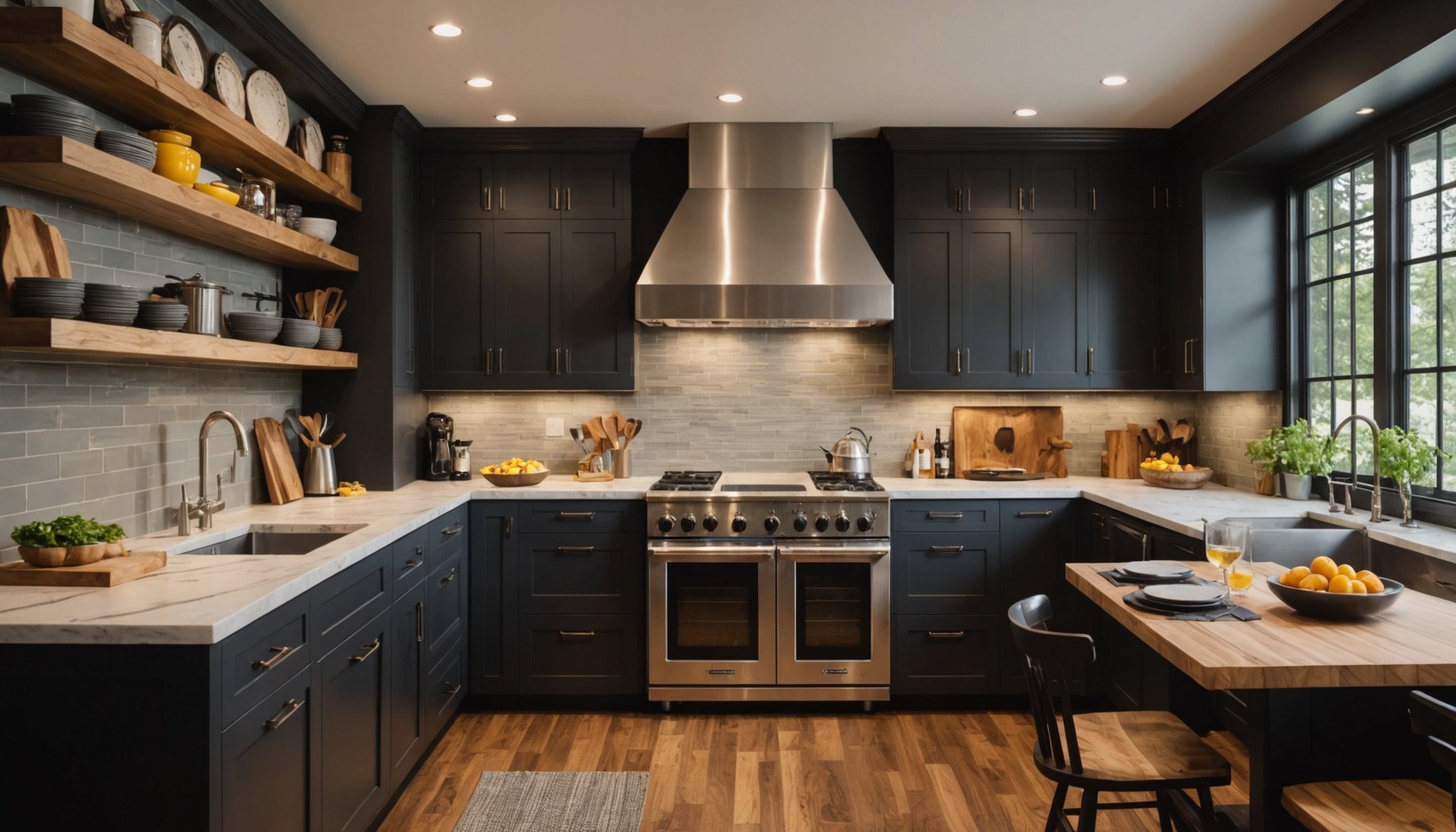Essential Appliances for a Dual Dietary Kitchen
In a kitchen that accommodates both meat and plant-based cooking, selecting the right kitchen appliances is crucial. If you’re wondering which ones to prioritize, consider those that offer multifunctional benefits. For example, a high-quality blender can effortlessly make creamy soups and smoothies, catering to diverse culinary preferences. Mixers with attachments to grind meats or blend vegetables also serve dual purposes effectively.
Cooking tools like induction cooktops, which provide precise temperature control, are invaluable for preparing varied meals without overcooking. Pressure cookers, too, simplify cooking times for lentils or tougher meat cuts, maximizing kitchen efficiency. Investing in appliances like air fryers and instant pots can save both space and time, making them perfect for busy households.
Also to discover : Designing Safe Kitchens for Seniors: Ingenious Solutions to Protect Our Aging Loved Ones
Moreover, when choosing multifunctional gadgets, consider their ease of maintenance. Appliances that are simple to clean prevent flavour transfers between meat and veggie dishes, supporting a respectful separation of dietary needs. In a dual cooking environment, opting for stainless steel surfaces or those with non-stick coatings is wise.
Ultimately, the right mix of versatile appliances and easy-to-clean gadgets can seamlessly support diverse cooking practices and preferences, turning your kitchen into an inclusive culinary hub.
Also read : Designing Harmony: Expert Tips for Creating a Cohesive Kitchen and Living Space
Kitchen Design Inspiration for Diverse Diets
Creating a kitchen design that accommodates diverse culinary preferences poses unique challenges and opportunities. To successfully blend styles for meat lovers and vegetarians, a multifunctional approach is key. Designing spaces that offer flexibility while maintaining distinct areas for different culinary tasks is essential.
Blending traditional and modern elements can create a harmonious environment. For instance, using natural wood for cabinetry along with sleek, stainless-steel appliances caters to both aesthetic and functional demands. Incorporating movable islands or extendable countertops can provide additional workspace when needed, promoting a versatile kitchen layout.
Effective design features, such as divided countertops and dual sinks, cater to the simultaneous preparation of meat and plant-based dishes, minimizing the risk of cross-contamination. Additionally, incorporating open shelving allows easy access and display of regularly used tools and ingredients specific to each diet.
Successful mixed-use kitchens, seen in various design examples, prioritize neutrality in color schemes, fostering a balanced atmosphere. Implementing smart storage solutions that hide clutter and keep items organized enhances usability and visual appeal. These kitchens not only support multiple dietary lifestyles but also inspire creativity through thoughtful design elements.
Creative Storage Solutions for Culinary Essentials
Creating a well-organized kitchen is essential for efficiently handling both meat and vegetarian ingredients. Utilizing the available space strategically is key. One effective strategy involves a pantry organization system that distinctly categorizes and stores meat-based and plant-based products. This separation helps prevent mingling of flavors and caters to the needs of diverse diets.
Another intelligent storage solution includes leveraging your drawer and cabinet space. Customized drawers can house specialized tools like vegetable peelers and meat thermometers, ensuring they are readily accessible yet neatly tucked away when not in use. This approach promotes an uncluttered kitchen environment.
Smart storage solutions are pivotal for households with dual cooking needs. Consider using tiered shelving or pull-out racks in cabinets to maximize space. These systems work well for segregating items needed for specific dietary preferences, reducing time spent searching for necessary ingredients during meal preparation.
Incorporating clear labels on containers also adds a layer of organization and helps avoid mix-ups. This technique is especially useful when storing bulk items such as grains or pastas. Ultimately, such planning caters to a more seamless cooking experience, which every enthusiastic home chef appreciates in a multi-diet kitchen setting.
Cooking Techniques that Accommodate Both Lifestyles
Understanding versatile cooking methods is essential in a kitchen supporting both meat and vegetarian dishes. Techniques like grilling or roasting can enhance flavors without compromising dietary preferences. Using marinades or spice rubs allows for a burst of taste, regardless of the main ingredient.
To ensure a smooth culinary process, focus on avoiding cross-contamination. Utilize separate utensils and cutting boards for meat and vegetables. Keeping your tools distinct and clean not only maintains flavor but adheres to hygiene standards. Encouraging this practice fosters respect for each diet choice.
Batch cooking emerges as a smart strategy, especially for busy cooks. By preparing items like grains or sauces in advance, tasks become more streamlined, and meal preparation can be a breeze. This approach is beneficial for family meals, as it saves time and maintains meal consistency.
Cross-applying these techniques can seamlessly adapt a menu for any guest, whether they are meat enthusiasts or plant-based diners. Exploring diverse, adaptable methods offers countless ways to enrich the dining experience while catering to everyone’s palate. Investing effort into these strategies improves efficiency and delight in culinary endeavours.
Recipe Suggestions for All Dietary Preferences
Cooking for both meat lovers and vegetarians can be a delightful culinary challenge, pushing the bounds of creativity. Embracing adaptable ingredients like mushrooms, zucchini, and lentils allows easy transitions between meals, serving both preferences. These versatile elements are often celebrated in cuisines worldwide, adding depth and flavour to dishes whether included in a hearty stew or a light stir-fry.
Meal ideas that cater to varied tastes include creating a base dish that is customisable. For instance, preparing a vibrant quinoa salad that can be elevated with grilled chicken or roasted chickpeas lets everyone personalise to their dietary needs. Similarly, a pizza night offering various toppings ensures inclusivity, as diners choose ingredients aligning with their preferences.
An effective approach to crafting inclusive dishes involves leveraging spices and herbs, enriching both meat-only and plant-based meals. Ingredients like cilantro, mint, or smoked paprika can elevate any culinary creation. By focusing on cooking recipes that celebrate diversity, including curries or mixed grain bowls, households can maintain cohesion in shared dining experiences.
Tips for Adaptable Meal Plans
- Focus on versatile ingredients suitable for various dietary needs.
- Craft base meals with customisable toppings or sides.
- Incorporate vibrant spices to appeal to all palates.
Visual Inspiration and Examples of Custom Kitchens
Creating a kitchen that caters to diverse culinary preferences hinges on innovative visual design. Successfully blending functionality with aesthetics can transform your kitchen into an inclusive culinary haven. Starting with a balanced colour palette, consider using neutral tones with vibrant accents. This approach fosters warmth and openness, welcoming both meat lovers and vegetarians alike.
Custom kitchen examples often showcase distinct areas for separate cooking styles. For instance, integrating dual countertops—one for plant-based prep and another meat-centric—promotes efficiency. Dedicated zones ensure style while minimizing cross-contamination. Adding movable islands enhances versatility, offering additional workspace whenever needed.
Excelling in kitchen design demands a keen understanding of visual elements. From open shelving to display cherished culinary tools, to cleverly placed lighting that highlights specific areas, each choice affects the kitchen’s overall appeal. Homes with [multifunctional spaces] often feature smart cabinetry solutions, hiding clutter while maximizing storage.
In conclusion, drawing inspiration from well-designed kitchens can inform your dream space. Delve into colour schemes and layouts that resonate, infusing personality into every corner. Whether you’re renovating or building from scratch, thoughtful design elements can invite harmony and creativity, yielding a kitchen both functional and visually captivating.











